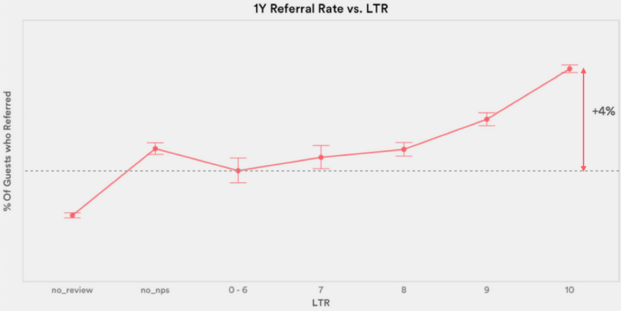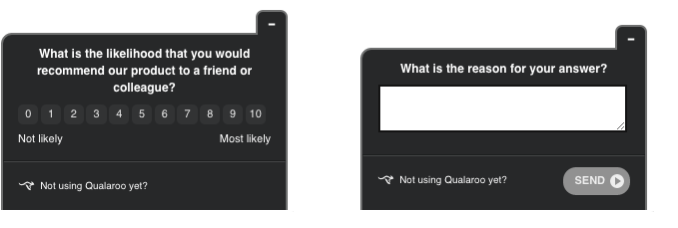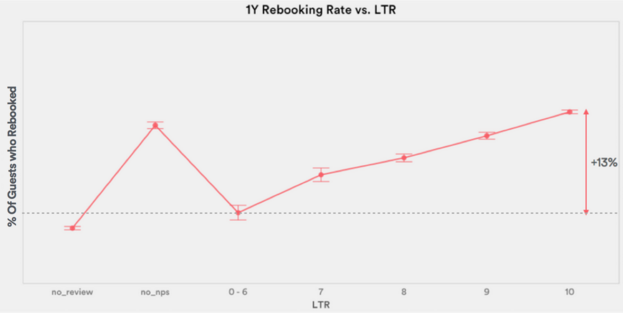In a time where every company needs to be data-informed, you can actually predict your customers’ likelihood to send a referral and even raise it higher with a customer feedback tool you’re probably already using: Net Promoter Score (NPS).
NPS captures how customers feel about your product and why with two simple questions:
Image source
It almost seems too simple to be useful, but the data doesn’t lie: companies with a higher NPS grow faster than their competition thanks to evangelical customers willing to put their reputation on the line and spread the word about their products.
This isn’t just true at the macro level. Successful companies are already using NPS to sniff out the customers most likely to refer friends. Here’s how they’re doing it, and how you can go a step further and use NPS data to make your referral program more effective.
How Airbnb Uses NPS to Predict Referral
Airbnb is famous for using data to improve and saw NPS as a huge opportunity. The company had its data team analyze the correlations between NPS’ likelihood to recommend (LTR) score and future actions like rebooking or referring a friend for the more than 600,000 users.
The data team started by separating users into seven cohorts: those who didn’t leave a review, those who left a review but skipped the NPS question, those who have an LTR between 0 and 6, and then, one each for the remaining LTR scores of 7-10.
Image source
First, the team measured those cohorts’ probability to book another trip on Airbnb within a year of their first trip. They found that the probability rose almost linearly with LTR. Users with an LTR of 10 were about 13% more likely to rebook within a year than detractors.
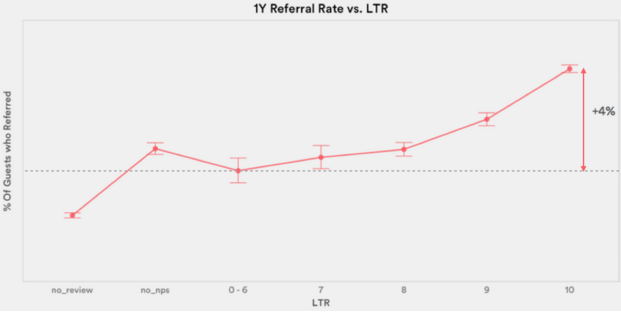
Image source
The trend was similar but not quite as pronounced when it came to correlation between LTR and probability of sending a referral through the Airbnb app. Users with an LTR of 10 were 4% more likely than detractors to refer.
You might think 4% doesn’t sound like much. But in Airbnb’s dataset of 600,000 customers, that 4% amounts to 24,000 advocates. Not to mention, the experiment only measures users who referred through Airbnb’s in-app referral program. It doesn’t account for users who may have just mentioned to their friends that they should give Airbnb a try.
While Airbnb doesn’t tell us how in this case study, we can be sure that its team used this data to improve the customer experience and drive more referrals. If you dig into the data, you can do the same thing with your product. Here’s how.
How to use NPS to Generate More Referrals
Here are three simple ways to use your NPS data to improve your referral program:
1. Close the loop with respondents
Customers who respond to your NPS survey—even ones who give you a bad rating—have taken the time to help your company improve. Following up afterwards is your way of repaying them and showing them that you’re committed to improving their experience.
Here’s how to follow up with NPS respondents depending on their LTR:
- Promoters (LTR is 9-10). The commitment principle tells us that once someone says they’ll do something, they feel compelled to deliver on their words with action. Tap into that. You can use a service like Customer.io to automatically send an email to any promoter after they respond, thanking them for their time and inviting them to refer.
- Passives (7-8). Typically, passives appreciate the value your product delivers but had an issue actually getting it. Topical example: If someone loves Pokemon Go but has trouble playing because the app crashes, their LTR would be a 7 or 8. But solving it would push them into promoter territory. If you’re using Qualaroo to collect NPS data, you can integrate with Slack to notify your customer success team as NPS responses come in. That way, they can delight respondents by solving these fixable issues quickly.
- Detractors (0-6). Most detractors’ complaints relate to the value your product, app or service provides. For instance, they often want new features or functionality. Push detractor responses to your product management team so that they can look for patterns and identify product changes that will drastically improve the customer experience moving forward. That’ll lead to more referrals down the line.
People will only refer your brand if they love it and feel confident their friends will too. Your NPS survey uncovers that exact information with its question on likelihood to recommend. By talking to customers who respond, you can either give them the slight nudge they need to refer or solve the problems that stop them from becoming advocates.
2. Double Down on Whatever Increases NPS
This isn’t about reading through the reasons customers give for their NPS score. You need to dig into the data, quantify as much of the customer experience as you can, and identify the parts that most strongly correlate with a higher rating.
Uber has one of the highest NPS scores of any company around, so we’ll use them as an example. There are so many small differences between every Uber ride: car cleanliness, trip length, the driver’s skill, etc.
But let’s say that after analyzing NPS data, Uber finds something most wouldn’t even think to look for: customers who have taken at least three rides in the more upscale UberBLACK option give a much higher LTR. Uber could act on that by offering more discounts on UberBLACK to customers who’ve yet to use the service.
That might sound like an overly simple message: “Improve your product and people will like it more.” But it’s about finding the right improvements. By finding the specific elements of each transaction that correlate most strongly with a higher NPS and working backwards from there, you can make the changes that will get your customers excited to spread the word about your product.
3. Know when to tweak the referral program
Tracking NPS can also let you know when the problem is with your referral program itself, rather than with your product.
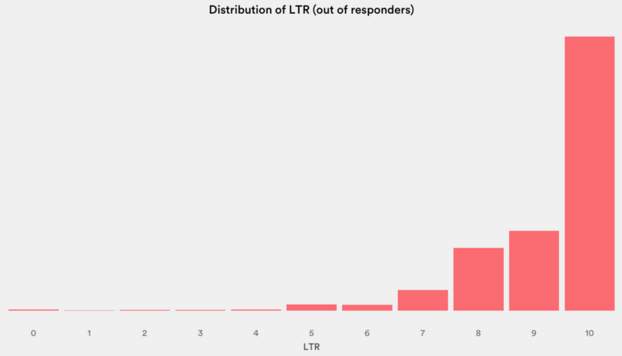
Image source
Take a look at the distribution of LTR scores from Airbnb’s NPS analysis. The vast majority of respondents were promoters. More than half pegged their LTR at a perfect ten.
Now, imagine if Airbnb still had these incredible scores, yet almost no one was referring. It would be incredibly frustrating to have all these customers telling you they’re willing to refer new customers but never actually doing so. But that’s the reality for many companies: In some industries, as few as 10% of promoters ever refer new business to the company.
If the NPS data is telling you that customers love your product, yet none of them are becoming advocates, the real problem must lie with your referral program – assuming you have one. Consider a few ideas to grease the wheels and get people referring:
- Make referral easier to find. No one will refer if they don’t know they have the chance. Try putting a link to your referral program front and center on your site’s homepage or navigation bar.
- Design referral to be seamless. Sharing a referral shouldn’t take more than a few clicks. Any instances of friction are a chance for advocates to say, “Forget it,” and give up, so make referring as easy as possible.
- Try a new reward structure. Maybe your rewards aren’t enticing enough. At Extole, we’ve found that an equal reward for both advocates and new customers drives the most referrals, but that might not be true for your product. Try out different rewards to keep your referral program going strong.
If the data is telling you that customers love your brand or product but the referrals aren’t coming in, you need to experiment with your referral program to figure out what tweaks will get more people sharing.
Use the Data you Already Have
You don’t need some groundbreaking new data source to understand what motivates your customers to refer. You just need to use what you already have in creative ways.
NPS is one of the simplest, most widely used customer feedback tools around. But it uncovers your most passionate customers and lets you quantify what separates them from everyone else. That tells you who to target for referral now, and what you need to do with your product to get more advocates down the road.
